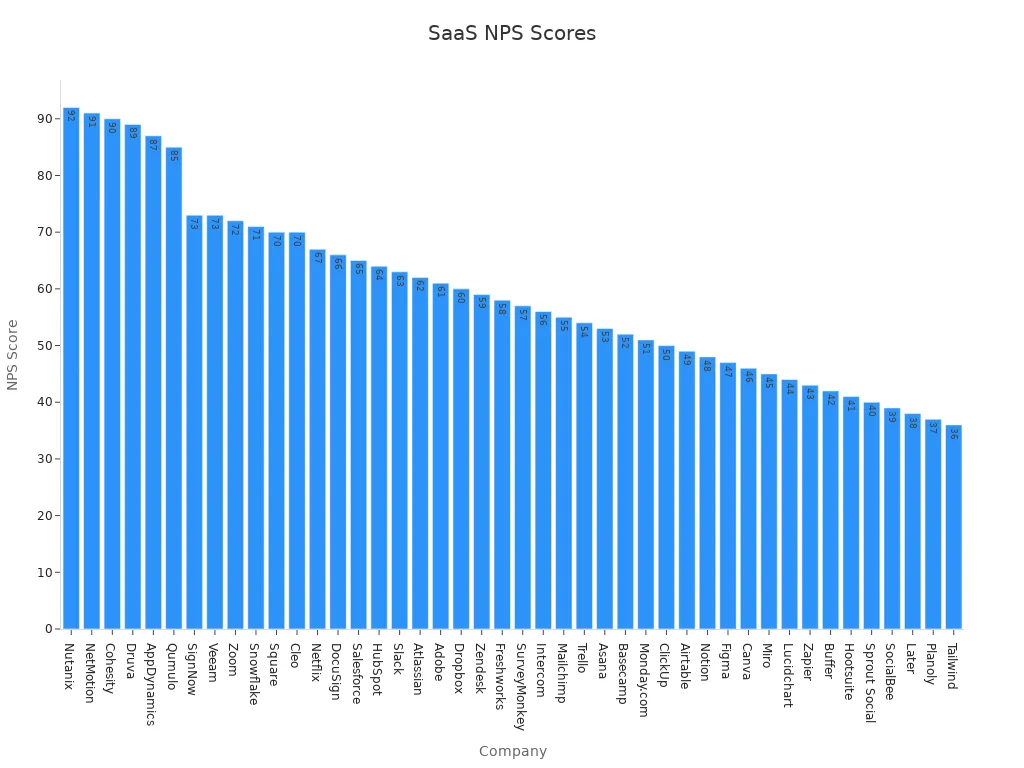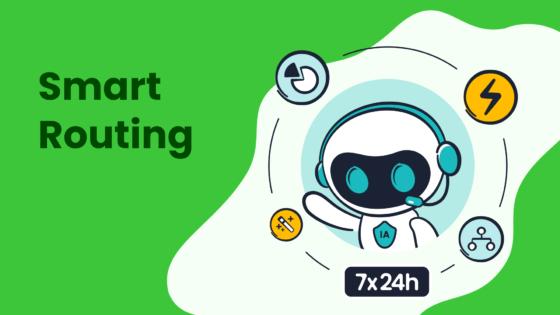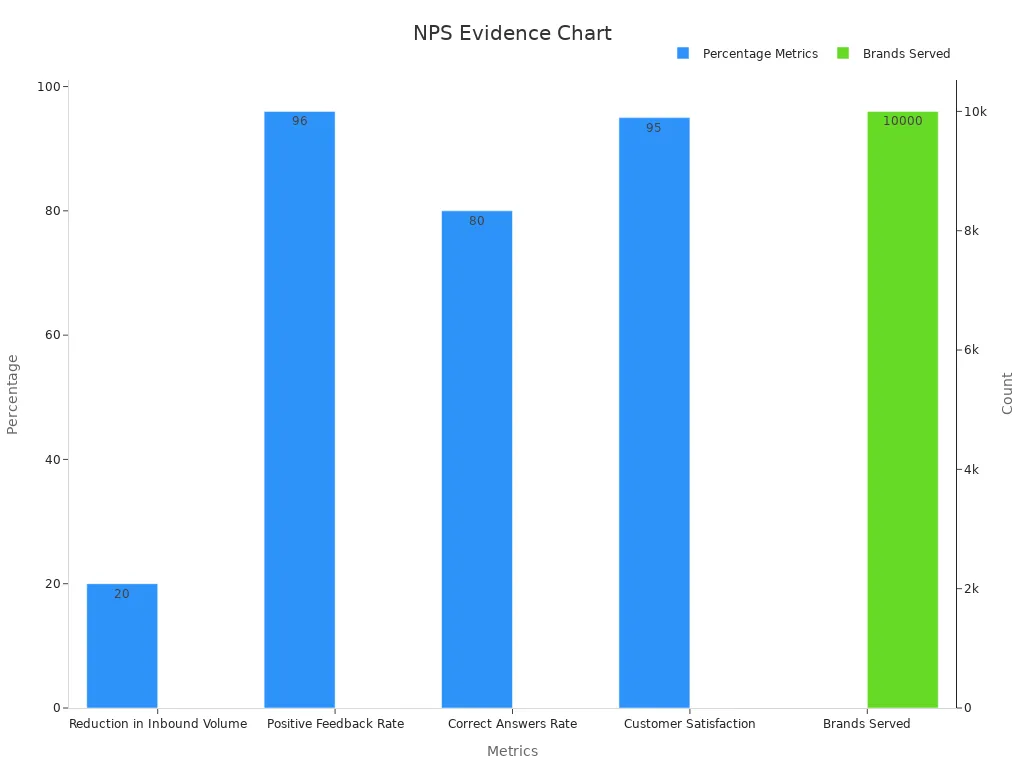What NPS Reveals About Industry Performance

The net promoter score (NPS) measures how likely customers are to recommend your business. It captures their satisfaction and loyalty, making it a vital metric for assessing overall performance. Industries use NPS benchmarks to uncover trends, compare themselves to competitors, and identify areas for growth. For example, B2B software companies average an NPS of 41, while healthcare improved its score by 7 points in 2025. Understanding net promoter score by industry gives you a powerful tool to track customer satisfaction and loyalty, ensuring you stay ahead in a competitive landscape. Sobot leverages these insights to enhance customer interactions and improve operational efficiency, helping businesses achieve higher NPS and better customer experiences.
NPS Trends in 2025 Across Industries

Key Patterns in Net Promoter Score by Industry
Understanding net promoter score patterns across industries helps you identify where your business stands. In 2025, industries like hospitality and travel lead with NPS ranges between 40 and 70, reflecting their focus on customer satisfaction. Technology and SaaS follow closely, scoring between 40 and 60. On the other hand, telecom struggles with scores ranging from 10 to 40, highlighting challenges in meeting customer expectations.
Here’s a breakdown of NPS ranges by industry:
| Industry | NPS Range |
|---|---|
| Technology & SaaS | 40-60 |
| E-commerce & Retail | 30-50 |
| Financial Services | 25-45 |
| Healthcare | 30-55 |
| Hospitality & Travel | 40-70 |
| Telecom | 10-40 |
| Automotive | 35-60 |
These industry benchmarks reveal that customer loyalty varies significantly. For example, retail and e-commerce businesses must focus on personalization to improve their scores. Meanwhile, telecom companies need to address service reliability to close the gap with higher-performing sectors.
Emerging Customer Experience Trends Shaping NPS
Customer experience trends in 2025 emphasize personalization and real-time feedback. Customers now expect tailored interactions, making personalized NPS surveys essential. Omnichannel feedback collection has also become a priority, ensuring you capture insights from social media, chatbots, and other platforms.
Here are some key trends shaping NPS:
| Trend | Description |
|---|---|
| Personalization | Customers expect tailored experiences, necessitating personalized NPS surveys and follow-ups. |
| Omnichannel Feedback | Feedback must be collected across various channels, including social media and chatbots. |
| Real-time Feedback Analysis | Businesses need tools for immediate analysis of NPS data to address customer concerns promptly. |
| AI-powered Insights | AI tools help uncover patterns in feedback, enhancing understanding of customer needs. |
For example, Sobot’s AI-powered solutions enable businesses to analyze feedback instantly, helping you address customer concerns before they escalate. This proactive approach not only improves your NPS but also strengthens customer loyalty.
The Role of Technology in Driving NPS Improvements
Technology plays a pivotal role in enhancing NPS. Businesses using AI and automation report a 20% improvement in scores and a 15% reduction in churn rates. Tools like Sobot’s Voice/Call Center streamline customer interactions with features like intelligent IVR and real-time monitoring. These innovations ensure you deliver seamless experiences, boosting customer satisfaction.
Organizations leveraging NPS strategies also achieve response rates exceeding 50%, showcasing the effectiveness of technology in engaging customers. By adopting advanced tools, you can stay ahead of industry benchmarks and foster long-term loyalty.
Industry-Specific NPS Insights
SaaS: Meeting High Expectations for Seamless Experiences
The Software-as-a-Service (SaaS) industry sets a high bar for customer satisfaction. Customers expect seamless experiences, fast issue resolution, and intuitive interfaces. The average net promoter score for the SaaS sector is +36, indicating positive performance but leaving room for improvement. Leading companies like Nutanix and NetMotion achieve NPS scores of 92 and 91, respectively, showcasing their ability to meet customer expectations consistently.
| Company | NPS Score |
|---|---|
| Nutanix | 92 |
| NetMotion | 91 |
| Cohesity | 90 |
| Druva | 89 |
| AppDynamics | 87 |


To achieve such high scores, SaaS companies focus on proactive customer support and robust technology. Tools like Sobot’s Voice/Call Center help businesses streamline interactions with features like intelligent IVR and real-time monitoring. These innovations reduce response times and improve first-contact resolution rates, directly impacting NPS. By leveraging these tools, you can enhance customer loyalty and stay competitive in this demanding industry.
Retail and E-Commerce: Personalization and Omnichannel Strategies
In retail and e-commerce, personalization drives customer loyalty and higher NPS scores. Studies show that customers who experience personalized interactions rate businesses 20% higher on NPS than those who don’t. Personalization creates lasting impressions, helping you build stronger connections with your audience.
- Personalized recommendations improve customer satisfaction and increase repeat purchases.
- Omnichannel strategies ensure seamless experiences across platforms, from mobile apps to in-store visits.
- Real-time feedback collection helps you address issues promptly, boosting your NPS score.
Sobot’s AI solutions empower retail businesses to implement these strategies effectively. For example, its omnichannel support integrates chat, email, and voice, allowing you to provide consistent service across all touchpoints. By adopting these tools, you can enhance customer satisfaction and achieve higher NPS benchmarks in this competitive sector.
Financial Services: Trust and Transparency as Key Drivers
Trust and transparency are critical for financial services to improve their NPS scores. Customers value clear communication, secure transactions, and ethical practices. A correlation analysis reveals that digital trust significantly enhances overall trust, making technology adoption essential for this sector.
| Evidence Type | Description |
|---|---|
| Trust Dimensions | Strong links between traditional and emerging dimensions of trust. |
| Digital Trust | Promoting technology adoption boosts systemic trust. |
| Gender-Specific Variations | Women show higher NPS despite lower overall trust, highlighting their influence. |
Financial institutions that prioritize transparency and adopt secure technologies see improved customer satisfaction. Sobot’s AI-powered solutions, like its Voice/Call Center, help financial services deliver personalized and secure interactions. These tools not only enhance trust but also streamline operations, enabling you to meet customer expectations and achieve higher NPS scores.
Healthcare: Patient-Centric Care and Its Impact on NPS
Patient-centric care has become a cornerstone of healthcare, directly influencing Net Promoter Scores (NPS). When you prioritize patient needs, you create a more positive experience, which leads to higher satisfaction and loyalty. This approach not only improves outcomes but also strengthens trust between patients and providers.
Patient-centric care focuses on personalized treatment plans, clear communication, and emotional support. For example, a cancer treatment center can engage satisfied patients, or Promoters, in storytelling campaigns. These patients share their recovery journeys, building trust among prospective patients. Testimonials from Promoters enhance your reputation through positive word-of-mouth, which directly impacts your NPS.
NPS results in healthcare often vary based on the type of medical condition or intervention. Studies show that patients undergoing total hip replacement report an NPS of 71, while those receiving total knee replacement report a lower score of 49. These variations highlight the importance of tailoring care to meet specific patient needs. By addressing these differences, you can improve satisfaction and loyalty across various services.
To achieve higher NPS, you should focus on creating a seamless patient experience. This includes reducing wait times, providing clear instructions, and offering follow-up care. Tools like Sobot’s AI-powered solutions can help you analyze patient feedback in real time, enabling you to address concerns promptly. When you adopt these strategies, you not only enhance patient satisfaction but also position your organization as a leader in patient-centric care.
Telecommunications: Overcoming Challenges in Customer Satisfaction
The telecommunications industry faces significant challenges in achieving high NPS. With an average score of 31, telecom companies rank the lowest among all industries. However, some companies have demonstrated that customer-centric strategies can lead to remarkable improvements. For instance, T-Mobile achieved an impressive NPS of 82 by focusing on personalized service and proactive problem-solving.
Telecom customers often experience frustrations related to service reliability, billing issues, and long wait times for support. These pain points contribute to low satisfaction levels. Despite these challenges, the industry has shown progress. Since 2018, telecom NPS benchmarks have improved by 13 points, reflecting a growing emphasis on customer experience.

To overcome these obstacles, you need to prioritize transparency and responsiveness. Offering clear billing information, resolving issues quickly, and providing consistent service can significantly improve customer satisfaction. Advanced tools like Sobot’s Voice/Call Center can help you streamline interactions. Features such as intelligent IVR and real-time monitoring enable you to address customer concerns efficiently, reducing frustration and boosting loyalty.
By adopting these strategies, you can close the gap with higher-performing industries. When you focus on delivering exceptional service, you not only improve your NPS but also build long-term trust with your customers.
Factors Influencing NPS in 2025
The Growing Importance of Customer Experience Trends
Customer experience trends are reshaping how businesses approach NPS in 2025. Research shows that improving customer experiences directly boosts retention, revenue growth, and referral rates. For example, companies integrating NPS with metrics like Customer Satisfaction (CSAT) and Customer Effort Score (CES) report a 20% improvement in satisfaction levels. This highlights the importance of a holistic approach to understanding customer needs.
However, a significant gap exists between businesses' perceptions and actual customer satisfaction. Bain & Company found that while 80% of businesses believe they deliver excellent experiences, only 8% of customers agree. This disparity underscores the need for advanced NPS methodologies. Tools like Sobot’s AI-powered solutions help you bridge this gap by analyzing feedback in real time, enabling you to address concerns proactively. By focusing on these trends, you can enhance customer retention and improve your NPS score.
Personalization and Its Role in Enhancing NPS Scores
Personalization has become a cornerstone of customer satisfaction. Studies reveal that businesses offering personalized experiences achieve NPS scores 20% higher than those that don’t. Customers are also 80% more likely to make a purchase when interactions feel tailored to their needs.
| Metric | Value |
|---|---|
| NPS Score Increase | 20% higher with personalization |
| Purchase Likelihood | 80% more likely with personalization |
You can implement personalization by leveraging tools like Sobot’s omnichannel solutions. These tools unify customer interactions across platforms, allowing you to deliver consistent and tailored experiences. For instance, personalized product recommendations or follow-ups can leave a lasting impression, boosting both customer retention and your NPS score. By prioritizing personalization, you not only meet customer expectations but also foster long-term loyalty.
AI and Automation: Transforming Customer Interactions
AI and automation are revolutionizing customer interactions, driving significant improvements in NPS. Organizations using AI report NPS increases of 10-15 points on average. These technologies enable you to provide proactive service, reducing frustration and enhancing loyalty.
The immediate feedback mechanism ensures that customer needs are prioritized, fostering trust and loyalty. Moreover, AI tools facilitate proactive customer service by encouraging representatives to ask deeper questions rather than merely reacting to inquiries.
Here’s how AI transforms customer interactions:
- Real-time insights help you address concerns before they escalate.
- Predictive analytics anticipate customer needs, improving satisfaction.
- Automation reduces response times, enhancing the overall experience.

Sobot’s AI-powered Voice/Call Center exemplifies these benefits. Features like intelligent IVR and real-time monitoring streamline interactions, ensuring you deliver seamless service. By adopting AI and automation, you can elevate your NPS score while building stronger relationships with your customers.
Brand Reputation and Its Effect on NPS
Your brand reputation plays a critical role in shaping your Net Promoter Score (NPS). A strong reputation builds trust, which directly influences how likely customers are to recommend your business. When customers perceive your brand positively, they are more inclined to become promoters, boosting your NPS and driving growth.
Studies show a significant correlation between NPS and future business performance. For example:
- NPS has an average correlation of 0.35 with future growth, compared to 0.28 for other metrics like the American Customer Satisfaction Index (ACSI).
- Over a four-year period, NPS shows a stronger correlation of 0.38 with growth, while ACSI lags at 0.13.
- A close relationship exists between NPS and ACSI, with a correlation of 0.83, highlighting the link between customer satisfaction and loyalty.
In industries like telecommunications, companies use NPS alongside metrics like Customer Effort Score (CES) to predict churn. By analyzing these metrics, you can identify dissatisfied customers and take proactive steps to retain them. This approach is especially valuable in saturated markets, where improving customer experience becomes a key differentiator.
Your brand reputation also impacts how customers perceive your service quality and reliability. For instance, telecom companies investing in customer experience improvements have seen reductions in churn rates. This demonstrates how a focus on reputation can enhance customer loyalty and improve your NPS.
To strengthen your brand reputation, prioritize transparency, consistency, and responsiveness. Tools like Sobot’s Voice/Call Center can help you deliver seamless interactions, ensuring customers feel valued. When you invest in building trust, you not only improve your NPS but also create lasting relationships with your audience.
Leveraging NPS for Business Success

Collecting and Analyzing NPS Data Effectively
To leverage NPS for business success, you must collect and analyze data effectively. Start by calculating your score. Subtract the percentage of detractors from the percentage of promoters. This simple calculation gives you a clear picture of customer sentiment. However, the real value lies in identifying trends over time. By tracking changes in your score, you can uncover patterns that reveal shifts in customer satisfaction and loyalty.
Segmenting feedback is another essential step. Break down NPS data by customer demographics, behavior, or product usage. For example, understanding how different age groups respond to your services can help you tailor strategies to meet their needs. Use data visualization tools like graphs and charts to make these insights more accessible. Clear visuals allow you to communicate findings effectively across your team.
Timing also plays a critical role in collecting meaningful feedback. Send surveys at strategic points in the customer journey, such as after a purchase or support interaction. This ensures you capture relevant insights without overwhelming your audience. Automating survey processes can further enhance efficiency. Tools like Sobot’s Voice/Call Center simplify this by enabling timely feedback collection through multiple channels, including voice and email.
To encourage participation, personalize your survey invitations. Address customers by name and reference their recent interactions. This approach makes them feel valued and increases engagement. Offering small incentives, such as discounts or loyalty points, can also boost response rates. When you implement these best practices, you not only gather accurate data but also strengthen customer engagement.
Closing the Feedback Loop to Improve Customer Loyalty
Closing the feedback loop is a powerful strategy to improve customer loyalty. When you act on customer feedback, you show that their opinions matter. This builds trust and encourages them to stay loyal to your brand. For instance, if a customer highlights an issue, resolving it promptly can turn a detractor into a promoter. Promoters are not only more likely to recommend your business but also generate 1.5 times more revenue than detractors.
Tracking improvements in your NPS over time is equally important. Instead of focusing solely on the absolute score, monitor how your actions impact customer satisfaction. Studies show that changes in NPS are predictive of sales growth. This means that enhancing your feedback mechanisms can directly influence your bottom line. For example, reducing churn by just 2% could help you retain an additional 2,000 customers, preserving $2 million in revenue.
To close the feedback loop effectively, start by categorizing feedback into actionable themes. Address common concerns first, as these often affect a larger portion of your audience. Communicate the changes you’ve made based on their input. Transparency fosters trust and demonstrates your commitment to improvement. Tools like Sobot’s AI-powered solutions can help you analyze feedback in real time, enabling you to act quickly and efficiently. By closing the loop, you not only enhance loyalty but also create a culture of continuous improvement.
Training Teams to Enhance Customer Interactions
Your team plays a crucial role in shaping customer experiences and, ultimately, your NPS. Well-trained employees can handle interactions more effectively, leaving a positive impression on customers. Start by equipping your team with the right tools and knowledge. For example, training them to use platforms like Sobot’s Voice/Call Center ensures they can manage calls and customer information seamlessly.
Focus on developing soft skills such as empathy and active listening. These qualities help your team connect with customers on a personal level, fostering loyalty. Role-playing exercises can prepare them for real-world scenarios, enabling them to handle challenging situations with confidence. Regular feedback sessions also help identify areas for improvement, ensuring your team continues to grow.
In addition to training, empower your team with actionable insights. Share NPS data and customer feedback with them, highlighting areas where they excel and where they can improve. This not only motivates them but also aligns their efforts with your business goals. When your team feels supported and informed, they are more likely to deliver exceptional service, boosting your NPS and customer satisfaction.
Using Sobot's Voice/Call Center to Boost NPS Scores
Sobot's Voice/Call Center offers a transformative solution for improving your Net Promoter Score (NPS). By streamlining customer interactions, it ensures faster resolutions and higher satisfaction rates. Businesses using this platform have reported remarkable improvements in their NPS metrics, thanks to its advanced features like intelligent IVR, real-time monitoring, and AI-powered voicebots.
Here’s a snapshot of how Sobot's Voice/Call Center impacts NPS metrics:
| Metric Description | Evidence |
|---|---|
| Brands Served | More than 10,000 brands have improved NPS |
| Reduction in Inbound Volume | 20% reduction in inbound discussion volume over two years |
| Positive Feedback Rate | Positive feedback increased to over 96% |
| Correct Answers Rate | Over 80% of answers provided by AI are correct |
| Customer Satisfaction | Over 95% of customers reported satisfaction |
| Problem Resolution Rate | 85% of problems are solved, with 99% customer happiness |

The platform’s intelligent IVR system allows you to customize greetings and route calls efficiently, reducing wait times. This feature alone can significantly enhance the customer experience. Additionally, the AI-powered voicebot handles repetitive queries, freeing up your agents to focus on complex issues. These capabilities not only improve first-contact resolution rates but also foster long-term loyalty.
For example, a retail business using Sobot's Voice/Call Center reduced its inbound call volume by 20% within two years. This reduction allowed agents to dedicate more time to high-value interactions, leading to a 96% positive feedback rate. Such results demonstrate how technology can directly influence your NPS and overall customer satisfaction.
By adopting Sobot's Voice/Call Center, you can deliver seamless, personalized experiences that resonate with your audience. This approach not only boosts your NPS but also strengthens your brand reputation, ensuring you stay ahead in a competitive market.
Setting Realistic NPS Goals for Continuous Improvement
Setting realistic NPS goals is essential for driving continuous improvement. Industry benchmarks provide a valuable framework for understanding where your business stands and where it can go. For instance, telehealth platforms often aim for NPS scores above 50, while dental practices target ranges between 50 and 70. Health insurers, on the other hand, typically operate within a lower range of 10 to 30.
Tip: Use industry benchmarks to identify gaps in your customer experience efforts. This will help you focus on areas that need the most attention.
Here are some ways benchmarks can guide your goal-setting process:
- They provide context for your NPS, helping you compare your performance with competitors.
- They reveal potential gaps in your customer experience, highlighting areas for improvement.
- They motivate your team by setting achievable targets based on industry standards.
When setting goals, consider both short-term and long-term objectives. For example, if your current NPS is 30, aim to increase it by 10 points within a year. Break this goal into actionable steps, such as improving response times or enhancing personalization. Tools like Sobot’s Voice/Call Center can play a crucial role in achieving these milestones by streamlining interactions and providing real-time feedback.
Tracking progress is equally important. Use data visualization tools to monitor changes in your NPS over time. Share these insights with your team to keep them motivated and aligned with your goals. Remember, even small improvements can have a significant impact. A 2% reduction in churn, for instance, could save millions in revenue while boosting your NPS.
By setting realistic, data-driven goals, you can create a roadmap for continuous improvement. This approach not only enhances customer satisfaction but also positions your business as a leader in delivering exceptional experiences.
Sobot's Role in Enhancing NPS Across Industries
How Sobot's All-in-One Contact Center Solutions Drive NPS
Sobot’s all-in-one contact center solutions empower businesses to improve their Net Promoter Score (NPS) by streamlining customer interactions. These solutions integrate advanced features like intelligent IVR, real-time monitoring, and AI-powered voicebots. By simplifying workflows, Sobot helps you reduce response times and enhance first-contact resolution rates. This directly impacts customer satisfaction and loyalty.
The effectiveness of Sobot’s platform is evident across industries. Businesses using Sobot have achieved a 22% increase in new accounts and a 30% reduction in average handle time. In the banking sector, companies leveraging Sobot’s tools have doubled their NPS compared to industry averages. These results demonstrate how Sobot’s technology transforms customer experiences, making it easier for you to meet and exceed expectations.
| Metric | Result |
|---|---|
| Increase in new accounts | 22% |
| Reduction in average handle time | 30% |
| NPS scores compared to banking | 2X |
When you adopt Sobot’s solutions, you gain the tools needed to deliver seamless, personalized service. This not only boosts your NPS but also strengthens your brand reputation.
Case Study: Samsung's Success with Sobot's Solutions
Samsung’s collaboration with Sobot showcases the transformative impact of Sobot’s solutions. Faced with the challenge of managing high volumes of customer inquiries, Samsung implemented Sobot’s all-in-one contact center platform. This integration unified Samsung’s communication channels, enabling agents to handle inquiries more efficiently.
The results were remarkable. Samsung achieved a 30% increase in agent efficiency and a 97% customer satisfaction rate. By leveraging Sobot’s intelligent tools, Samsung reduced repetitive tasks and provided personalized support to VIP customers. These improvements significantly enhanced Samsung’s NPS, demonstrating the value of Sobot’s technology in driving customer loyalty.
The Impact of Sobot's AI-Powered Voice/Call Center on Customer Satisfaction
Sobot’s AI-powered Voice/Call Center plays a pivotal role in improving customer satisfaction. Its intelligent IVR system routes calls efficiently, reducing wait times. The AI-powered voicebot handles repetitive queries, freeing agents to focus on complex issues. These features ensure faster resolutions and higher satisfaction rates.
For example, businesses using Sobot’s Voice/Call Center have reported an 85% problem resolution rate and a 96% positive feedback rate. These metrics highlight how Sobot’s technology enhances the customer experience. When you adopt this platform, you can deliver seamless interactions that leave a lasting impression, boosting both satisfaction and your NPS.
NPS trends in 2025 reveal how industries are evolving to meet customer expectations. For example, SaaS companies focus on AI-driven support, while retail emphasizes ultra-fast deliveries and personalization. The table below highlights key benchmarks and trends across sectors:
| Industry | 2025 NPS Benchmark | Key Trends |
|---|---|---|
| SaaS & Tech | 40-55 | AI-driven support, freemium-to-premium strategies, security concerns. |
| E-commerce & Retail | 35-50 | Ultra-fast deliveries, AI-driven personalization, ethical sourcing. |
| Financial Services | 25-45 | Digital banking, personalized financial tools, trust and security concerns. |
| Healthcare & Telemedicine | 30-55 | AI diagnostics, virtual consultations, data privacy concerns. |
| Hospitality & Travel | 45-70 | AI concierge services, personalized loyalty programs, sustainable tourism. |
| Telecommunications | 20-40 | AI self-service solutions, pricing transparency, network reliability. |
| Automotive Industry | 30-50 | EV adoption, subscription models, post-purchase service. |
Using NPS as a tool helps you track customer loyalty and satisfaction, ensuring your business stays competitive. Sobot’s solutions, like its AI-powered Voice/Call Center, empower you to deliver seamless experiences, boosting your score and fostering long-term trust. By adopting these tools, you can align with industry trends and achieve sustainable growth.
FAQ
What is the Net Promoter Score (NPS)?
NPS measures how likely your customers are to recommend your business. It categorizes them as promoters, passives, or detractors based on their responses. This score helps you understand customer loyalty and satisfaction, making it a vital metric for improving your business performance.
How can NPS help improve customer satisfaction?
NPS highlights areas where your business excels and where it needs improvement. By acting on customer feedback, you can address concerns, enhance experiences, and build stronger relationships. This proactive approach boosts satisfaction and loyalty over time.
Why is NPS important for businesses in 2025?
NPS provides insights into customer loyalty trends, helping you stay competitive. It allows you to benchmark against industry standards, identify gaps, and implement strategies to improve. In 2025, businesses using NPS effectively will better meet evolving customer expectations.
How does technology impact NPS?
Technology simplifies feedback collection and analysis. Tools like Sobot’s Voice/Call Center enable real-time monitoring and personalized interactions. These innovations improve response times and resolution rates, directly enhancing customer satisfaction and boosting your NPS.
Can NPS predict business growth?
Yes, NPS correlates with future growth. Higher scores indicate strong customer loyalty, which drives referrals and repeat business. Tracking NPS trends helps you identify opportunities to expand and improve your market position.
See Also
Best Call Center Analytics Tools To Use In 2024
Enhancing Call Center Efficiency Through Effective Monitoring
Comparative Review of Leading Voice of Customer Software
